September 19, 1996 04:36 PM | Permalink | ![]()
By all accounts, 1995 was a very good year for American business. According to the Commerce Department, corporate pretax profits jumped by 14 percent in 1995–to a record $600.8 billion.(1) Yet despite strong profits and a growing economy, American corporations laid off more than 400,000 workers during 1995. An additional 230,350 layoffs were announced in the first five months of 1996–a 34 percent increase over the same period last year.(2) Public anxiety over the latest surge in corporate downsizing has spurred loud expressions of professed concern from elected officials and candidates.
Government policy, however, is not acting to curb corporate downsizing. On the contrary, a Citizens for Tax Justice analysis of the annual reports of ten of the largest downsizing corporations finds that these companies receive huge federal subsidies, implemented through the tax system. Unfortunately, the 104th Congress has not only failed to close the tax breaks that reward these downsizing companies. It has also proposed and passed several provisions that would expand the loopholes most often used by these companies to avoid taxes.
THE “LAYOFF TEN”:  A SUMMARY
A SUMMARY
Citizens for Tax Justice has analyzed the annual reports of ten of America’s largest companies that have engaged in large-scale layoffs over the past three years. We found that while these companies were laying off workers, they were taking advantage of billions of dollars in tax subsidies and boosting the already high salaries of their top corporate executives.
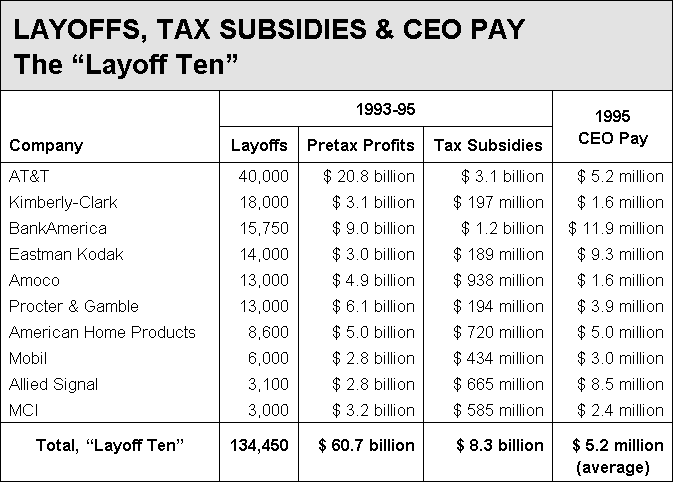
- Together, these ten companies announced or implemented layoffs of 134,450 workers over the 1993-95 period.
- At the same, the ten companies received $8.3 billion in federal tax subsidies, tax breaks that drove their effective tax rates far below the 35 percent tax rate that large, profitable companies are supposed to pay.
- While average workers for downsizing corporations face sacrifices, the CEOs of these companies have enjoyed significant salary increases, in many cases as a direct result of the large-scale layoffs they have imposed. In fact, these ten companies rewarded their CEO’s with compensation packages averaging $5.2 million in 1995.
In fact, it appears to be almost a general rule that CEOs for companies that laid off workers have done the best for themselves in terms of pay. In 1995, average CEO salaries and bonuses jumped by 18 percent to $1.7 million.(3) But Business Week found that the CEOs of the 20 companies with the largest announced layoffs last year saw their salaries and bonuses jump by 25 percent.
CONGRESSIONAL ACTION–AND INACTION
Responding to growing anxiety over the latest round of corporate downsizing, politicians and candidates have denounced corporate welfare and promised protection for workers. In fact, however, the 104th Congress has done little to address the problem. Instead, it has maintained–and even proposed to enlarge–the tax subsidies that downsizing companies enjoy.
For starters, the 104th Congress has simply failed to close many of the existing tax loopholes enjoyed by profitable, downsizing corporations. For example:
- Corporate mergers and acquisitions frequently lead to plant closings and layoffs. Yet the interest on the debt used to finance these mergers is tax-deductible, providing an effective subsidy for corporate raiding.
- The tax code’s complex rules for taxing multinational corporations fail to make these companies pay their fair share in taxes, and can even encourage multinational corporations to move jobs overseas.
- While there are some supposed limits on the deductibility of “excessive” salaries for corporate executives, those limits do not apply to so-called “performance based” compensation. This rule allows corporations to deduct in full compensation linked to stock performance. Downsizing has been one potential way to boost stock prices. In fact, the ten companies analyzed in this study experienced a 54 percent average increase in their stock prices between 1992 and 1995.
- Finally, Congress has yet to touch a myriad of industry-specific loopholes that benefit oil, gas and timber companies, insurance companies, banks. These subsidies increase the profitability of the largest, most politically influential corporations regardless of their performance or their treatment of their workers.
In addition, the majority in Congress has actually voted to expand the tax breaks enjoyed by many of the companies examined in this study. For example, the “Contract with America Tax Relief Act” (H.R. 1215), which passed the House of Representatives on April 5, 1995, provided huge corporate tax cuts, many of which directly benefit companies that have been downsizing.
- The bill contained a huge cut in the capital gains tax rate, which can encourage corporations and shareholders to engage in short term speculation rather than long-term investments in workers and equipment.
- The bill also contained a so-called “neutral cost recovery” system of depreciation, designed to allow companies to take total deductions on the purchase of equipment that are considerably greater than the actual cost of the equipment. Combined with other tax breaks, companies could use this break to produce negative marginal tax rates–allowing corporations to exploit loopholes to make a profit off of the tax system.
- Finally, the bill repealed the Alternative Minimum Tax, which serves as a “backstop” to prevent corporations and individuals from using loopholes to avoid paying taxes altogether. Repeal of the AMT would allow many highly profitable corporations to become “corporate freeloaders”–paying little or no taxes.
The “Contract With America Tax Relief Act” passed the House of Representatives, but never was brought to a vote in the Senate. But the 1996 Budget Reconciliation Bill (H.R. 2491) contained many similar or identical tax break provisions, including a big cut in capital gains taxes and a sharp reduction in the Alternative Minimum Tax. That bill also increased taxes on 7.7 million working households with 6.8 million children by cutting the Earned Income Tax Credit, and encouraged corporations to raid their workers’ pension funds by eliminating tax penalties on such withdrawals. These provisions passed both the House and Senate, but were dropped from the final budget after the President’s veto.
THE LARGEST CURRENT & PROPOSED CORPORATE TAX BREAKS (4)
Accelerated Depreciation: Accelerated depreciation allows corporations to deduct the cost of equipment and buildings faster than they wear out. This break results in corporations avoiding taxation on huge amounts of profits. In 1995, for example, accelerated depreciation allowed Eastman Kodak to avoid $124 million taxes and Allied Signal to avoid $51 million. Corporations can combine accelerated depreciation with interest deductions to yield negative tax rates–making equipment investments yield higher profits after taxes than before taxes. Accelerated depreciation write-offs cost the Treasury about $39 billion per year.
Attacks on the Alternative Minimum Tax: The current corporate Alternative Minimum Tax was enacted after it was discovered that some companies were able to take advantage of tax breaks like accelerated depreciation to avoid paying income taxes altogether. In fact, between 1981 and 1986, half of a sample of 250 of America’s largest, most profitable corporations managed to have at least one entirely tax-free year. Examples include Allied Signal, with an effective tax rate of -16.3 percent between 1982 and 1985,(5) Mobil and Scott Paper (which was later acquired by Kimberly-Clark).
The AMT requires companies to pay at least some income tax no matter how many loopholes they may find in the regular corporate tax code. The “Contact With America Tax Relief Act” would have repealed the minimum tax entirely. That would once again have allowed many profitable companies to pay no federal taxes whatsoever.
Capital Gains Tax Breaks: Gains on the sale of appreciated assets like real estate or stock, get a special, lower top tax rate under the personal income tax, but for corporations, realized capital gains are currently taxed the same as other kinds of profits. The congressional tax plans proposed to cut both the individual and the corporate capital gains tax rates–with the latter tax break extended to ordinary profits for timber and certain other industries.
Multinational Corporations: A number of tax-sheltering strategies are available to multinational corporations to avoid paying U.S. taxes on their profits. Among other things, companies can to “defer” taxes on the profits of their overseas subsidiaries and use complex “transfer pricing” schemes to shift profits (on paper) out of the U.S. In some cases, these rules actually encourage corporations to move jobs to foreign tax havens. Tax avoidance strategies of this sort cost the federal Treasury tens of billions of dollars a year.
Industry-Specific Tax Subsidies: Besides being able to take advantage of the above loopholes, certain industries have their own, industry-specific tax subsidies. The oil, gas and energy industries, for example, will get $22 billion in special tax breaks over the next seven years. These include immediate write-offs for “intangible” exploration and development investments as well as percentage depletion allowances that simply exempt a percentage of profits from tax. Timber, mineral, and agriculture industries also benefit from billions in targeted tax subsidies.
THE LAYOFF TEN: A DETAILED LOOK

AT&T
AT&T announced the largest and most publicized recent layoffs. The company, which made $20.8 billion in pretax profits between 1993 and 1995, announced in January 1996 that it would cut 40,000 jobs over the next three years–with 18,000 of that from “involuntary” layoffs. Meanwhile, AT&T’s CEO, Robert Allen, received $3.3 million in direct salary and compensation and bonuses. Allen directly benefitted from the layoffs, as AT&T’s share price increased $21/8 the day of the layoff announcement. This increased the value of Allen’s stock options by $3.4 million, and the value of his total compensation package to $5.2 million.
Between 1993 and 1995, AT&T received $3.1 billion in federal tax subsidies. In 1995 alone, the company received tax breaks totaling $1.6 billion, the majority from accelerated depreciation. Over the three-year period, AT&T paid an effective tax rate of just 19.9 percent.
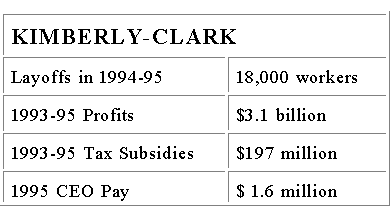 KIMBERLY-CLARK
KIMBERLY-CLARK
On December 13, 1995, Kimberly-Clark announced that it would cut 6,000 jobs by the end of 1997, on top of 12,000 layoffs announced in 1994 by its subsidiary Scott Paper (acquired in 1994). Meanwhile, over the 1993-95 period, the company received a total of $197 million in tax subsidies.
Wayne Sanders, Kimberly Clark’s Chairman and CEO, received salary and bonuses amounting to $1.6 million, a 44 percent increase from 1994. In addition, the value of Sanders’s stock options in the company rose by an estimated $884,000 after the company announced its latest round of layoffs.
 BANKAMERICA
BANKAMERICA
In October 1993, BankAmerica announced that it was cutting 3,750 jobs, on top of the 12,000 it had eliminated in 1992. Meanwhile, BankAmerica’s U.S. profits jumped from $2.5 billion in 1993 to $3.7 billion in 1995. The company paid just 21.3 percent of its $9.0 billion in pretax U.S. profits in federal taxes in 1993-95, receiving $1.2 billion in tax subsidies.
Richard Rosenberg, BankAmerica’s Chairman, President, and CEO, was one of the 20 highest paid Chief Executives in the country during 1995. Rosenberg’s salary and bonus totaled $4.5 million–a 45 percent increase over his 1994 salary. Rosenberg’s long-term compensation package added an additional $7.3 million, bringing his total 1995 compensation to $11.9 million. Rosenberg resigned at the end of 1995.
 EASTMAN KODAK
EASTMAN KODAK
Eastman Kodak, the maker of Kodak film and cameras, employed about 96,600 workers worldwide at the end of 1995. In August 1993, Eastman Kodak announced it was cutting 10,000 jobs by the end of 1995. It announced an additional 4,000 layoffs in December 1994. From 1993 to 1995, Eastman Kodak recorded $3.0 billion in pretax U.S. profits. Meanwhile Eastman Kodak received $189 million in tax subsidies, mostly in the form of accelerated depreciation. Eastman Kodak’s effective tax rate for 1995 was only 17.3 percent, and its three-year tax rate was well below the 35 percent statutory corporate tax rate.
Kodak’s Chairman, President and CEO, George M.C. Fischer, received salary and bonuses of $4.3 million in salary and bonuses during 1995, a 10 percent increase from 1994. In addition, Fischer received almost $7 million in a long-term compensation package, including forgiveness of a $2 million loan.
 AMOCO
AMOCO
Amoco, one of the country’s largest oil companies, announced in July 1994 that it planned to eliminate 3,800 positions by the end of 1995 and 700 more jobs by the end of 1996. The company also announced the elimination of 8,500 jobs in 1992, bringing the combined total layoffs to 13,000 jobs–roughly one quarter of Amoco’s work force.
Between 1993 and 1995, Amoco reported $4.9 billion in pretax U.S. profits, but paid an effective income tax rate of just 15.9 percent. Tax subsidies to Amoco over this period amounted to $938 million. In 1995 alone, the company claimed $179 million in tax credits and $71 million in other tax breaks. Amoco’s CEO, H. Laurance Fuller, meanwhile, was paid $1.6 million in 1995.
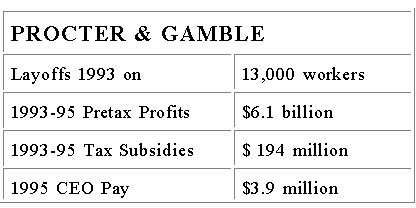 PROCTER & GAMBLE
PROCTER & GAMBLE
Proctor & Gamble is one the largest manufacturers and distributors of consumer goods in the world, specializing in laundry and paper products. Since 1993, Procter & Gamble has announced layoffs totaling 13,000 jobs–approximately 12 percent of its 1993 workforce. Over the same period of time, Procter & Gamble recorded pretax U.S. profits of $6.1 billion. Procter & Gamble received a total of $194 million in tax subsidies over the three-year period.
Procter & Gamble’s chairman, Edwin L. Artzt, was paid $2.9 million in salary and bonuses–a 26 percent raise over 1994. He also received $1.1 million in long-term compensation. Artzt retired from the company in July 1995.
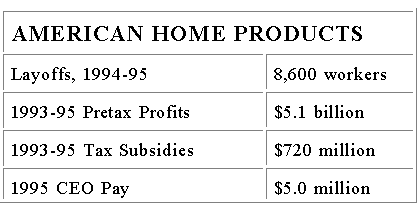 AMERICAN HOME PRODUCTS
AMERICAN HOME PRODUCTS
American Home Products is one of the top three companies in prescription drug sales and is a leading manufacturer of pharmaceuticals and medical supplies. It markets products such as Advil, Anacin, Dristan, ChapStick and Chef Boyardee canned foods. American Home Products is also a major pesticide manufacturer. In 1994, it acquired American Cyanamid, another major pharmaceutical company for approximately $9.6 billion.
At the end of 1994, American Home employed 74,000 workers. But the combination of layoffs announced in July and November of 1994 and January 1995 meant that American Home eliminated a total of 8,600 of those positions in 1995.
Over the past three years, American Home received $720 million in federal tax subsidies. These included, among other things, tax breaks for operating in Puerto Rico and foreign tax havens, accelerated depreciation tax breaks, and research tax credits. American Home earned $5.1 billion in pretax U.S. profits over the 1993-95 period, but its effective tax rate was only 21 percent.
American Home’s CEO, John Stafford enjoyed a total compensation package in 1995 of $5 million, including $2.4 million in salary and bonuses, $2.2 million in exercised stock options and $300,000 in long-term pay. He also benefitted from a jump in the company’s stock value following the January 1995 layoffs.
 MOBIL
MOBIL
Mobil Oil Company has announced 6,000 layoffs since May 1, 1995, just one week before it announced a large jump in first-quarter profits. In fact, during 1995, Mobil’s U.S. pretax profits totaled $1.8 billion–almost four times the amount it earned in 1994. Over the three-year period 1993-95, Mobil received $434 million in tax subsidies.
Mobil’s CEO, Lucio Noto, received $1.6 million in salary and bonuses during 1995, a 16 percent raise over 1994. Noto also received another $1.5 million in long-term compensation, for a total of $3 million in 1995. Noto did extremely well as a direct result of the layoffs. Immediately after the layoffs were announced, Mobil stock jumped $37/8, increasing the value of options held by Noto by an estimated $24 million.

ALLIED SIGNAL
Allied Signal produces parts for military aircraft and missiles, as well as automobile parts, plastics and fibers. During 1994, Allied Signal reported almost $1.9 billion in sales to the federal government, including $1.3 billion in defense contracts or subcontracts. The company employed approximately 87,500 employees in 1994.
On October 27, 1995, Allied Signal announced that it would lay off 3,100 workers. A short time later, Allied Signal announced record third-quarter profits.
Over the past three years, Allied Signal received $665 million in federal tax subsidies while reporting $2.8 billion in pretax U.S. profits. The company paid an effective tax rate over these three years of just 11.2 percent–less than a third the statutory corporate tax rate. In 1995 alone, the company got $51 million in accelerated depreciation tax breaks, $19 million in foreign sales corporation credits, and close to $200 million in other special tax breaks.
Allied Signal’s CEO, Lawrence Bossidy, received $4.4 million in 1995 in salary and bonus, a 20 percent increase from 1994. In addition, the increased value of Bossidy’s stock options and incentives increased his total pay to an estimated $8.4 million.(6) Bossidy’s compensation package was boosted considerably when, on the day Allied Signal announced its layoffs, its stock price jumped by $2 per share, increasing the total value of Bossidy’s stock options by $5.1 million.(7)
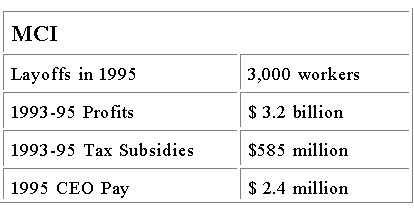 MCI
MCI
MCI Communications Corporation announced last year that it would trim its workforce by 3,000 jobs–more than 7 percent of its total workforce. Meanwhile, the company recorded $874 million in pretax U.S. profits during 1995, bringing its total for the past three years to $3.2 billion. Over that same three years, the company received $585 million in tax subsidies, cutting its effective tax rate to only 16.5 percent.
MCI’s Chairman and CEO, Bert Roberts Jr., was paid $2.2 million in salary and bonuses, a 33 percent raise from 1994. MCI’s stock increased by $1.80 immediately after the layoffs were announced, pushing the value of Roberts’ options up by an estimated $756,000.
More Detailed Tables …
1. U.S. Dept. of Commerce, Bureau of Economic Analysis, Survey of Current Business, April 1995, Table 1.14, p. 15.
2. Challenger, Grey & Christmas, June 1996.
3. “How High can CEO Pay Go?” Business Week, April 22, 1996. By comparison, the average factory workers’ salary increased jut 1 percent last year. The average professional workers’s salary increased by 4.2 percent.
4. For a more extensive look at these and other related “tax expenditures” enjoyed by both individuals and corporations, see the CTJ’s The Hidden Entitlements (May 1996).
5. A negative tax rate indicates that rather than paying taxes, a corporation was able to use excess deductions to get a refund for taxes paid in earlier years.
6. CEO Compensation from “The Business Week Executive Compensation Scorecard,” Business Week, April 22, 1996, p.107
7. Information on CEO stock options from “CEO’s Win, Workers Lose,” Institute for Policy Studies, April 24, 1996.



